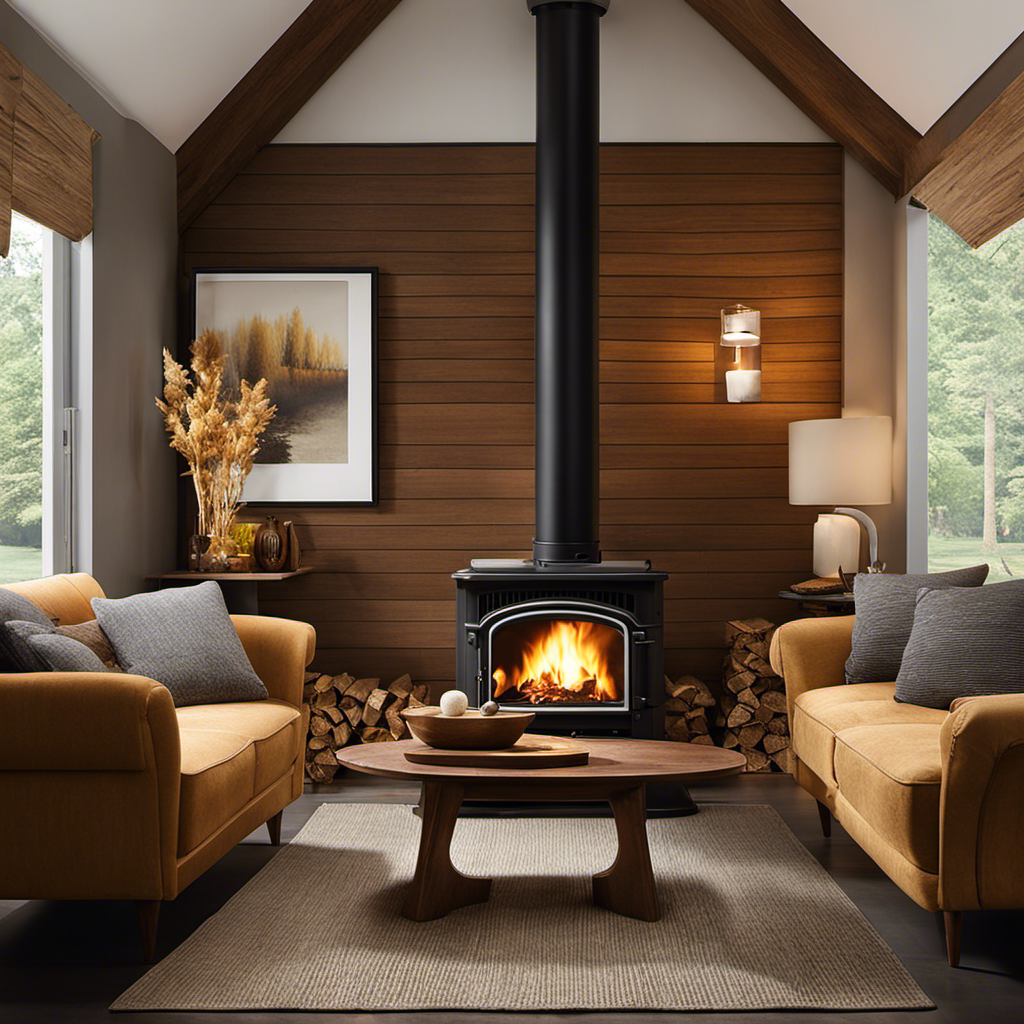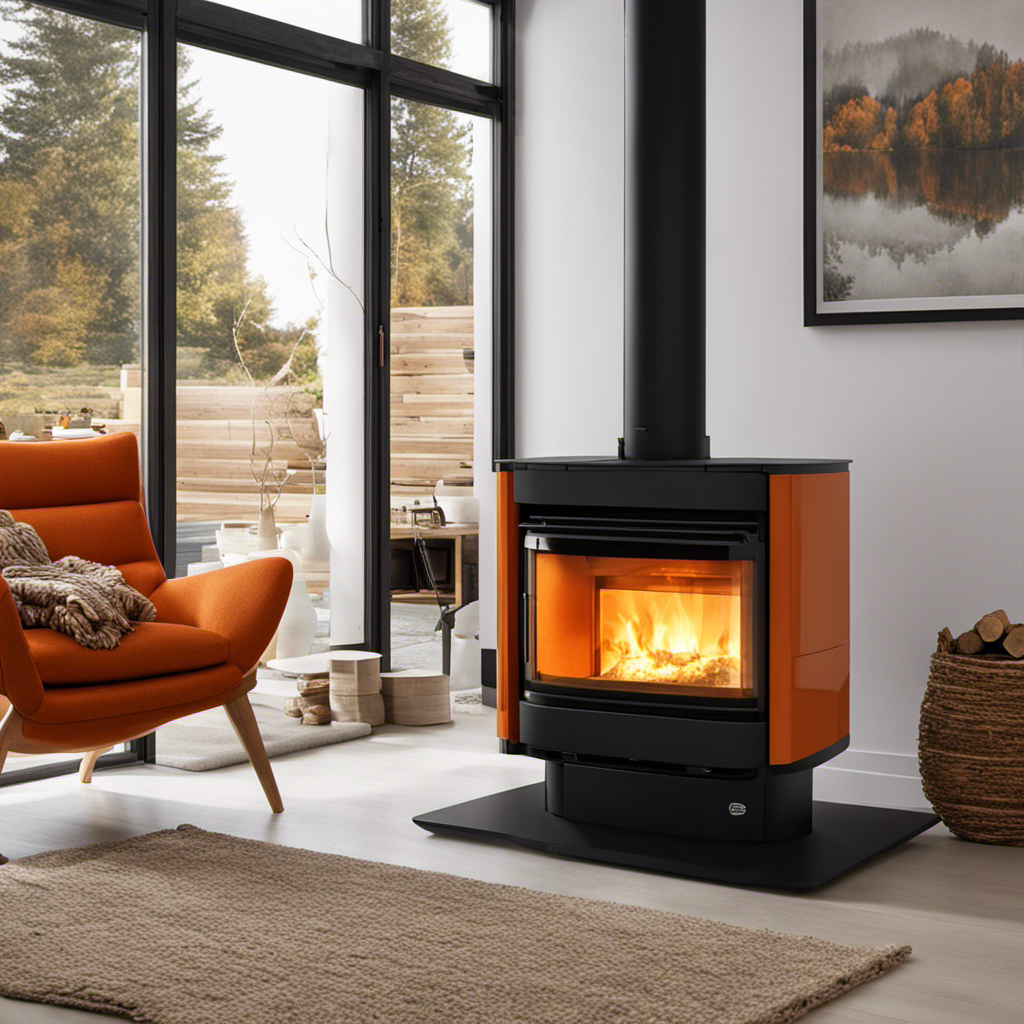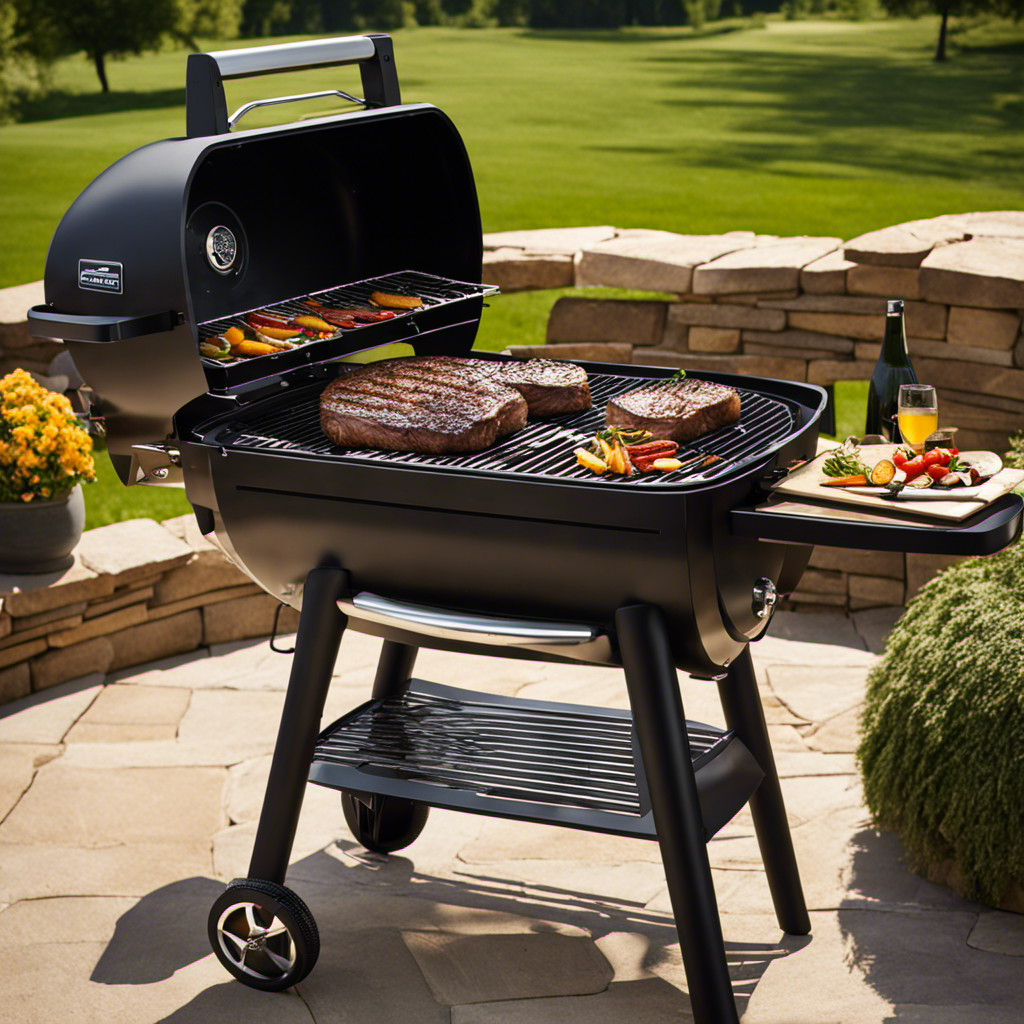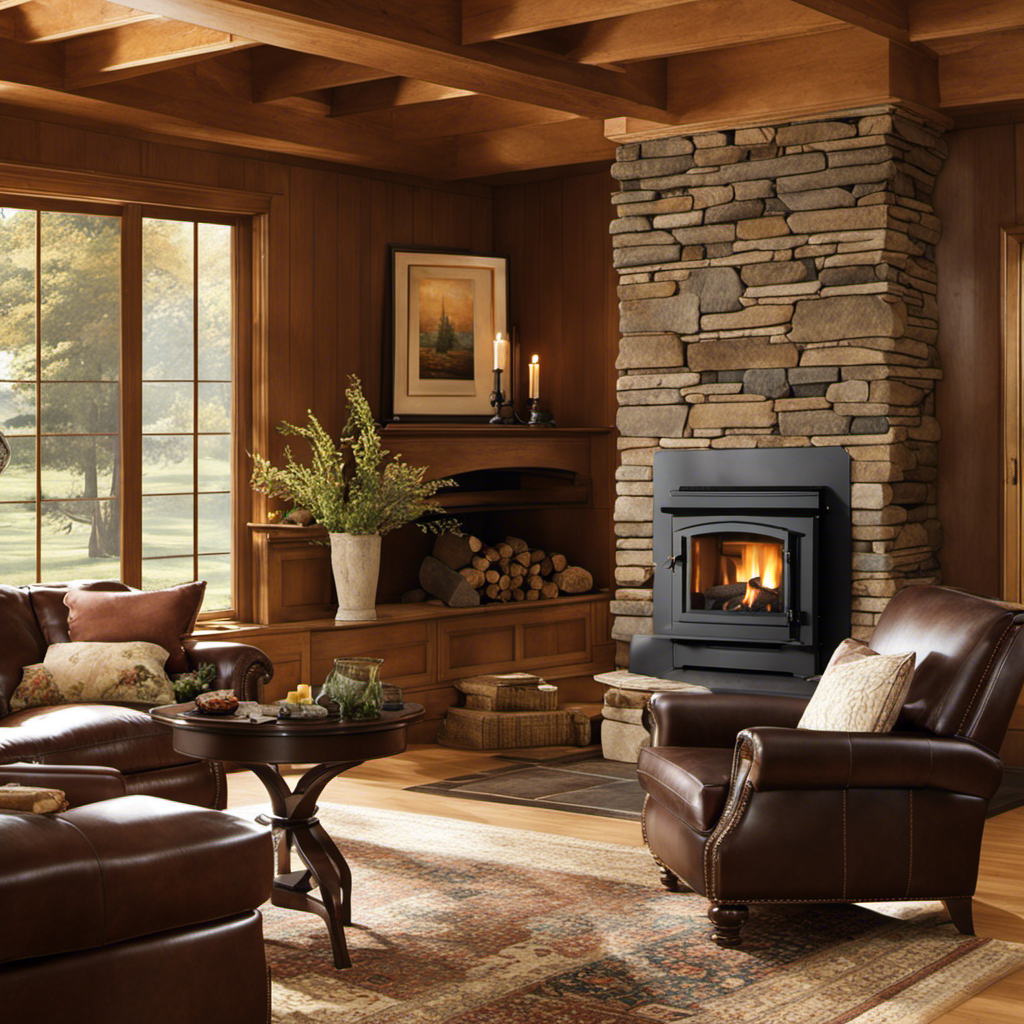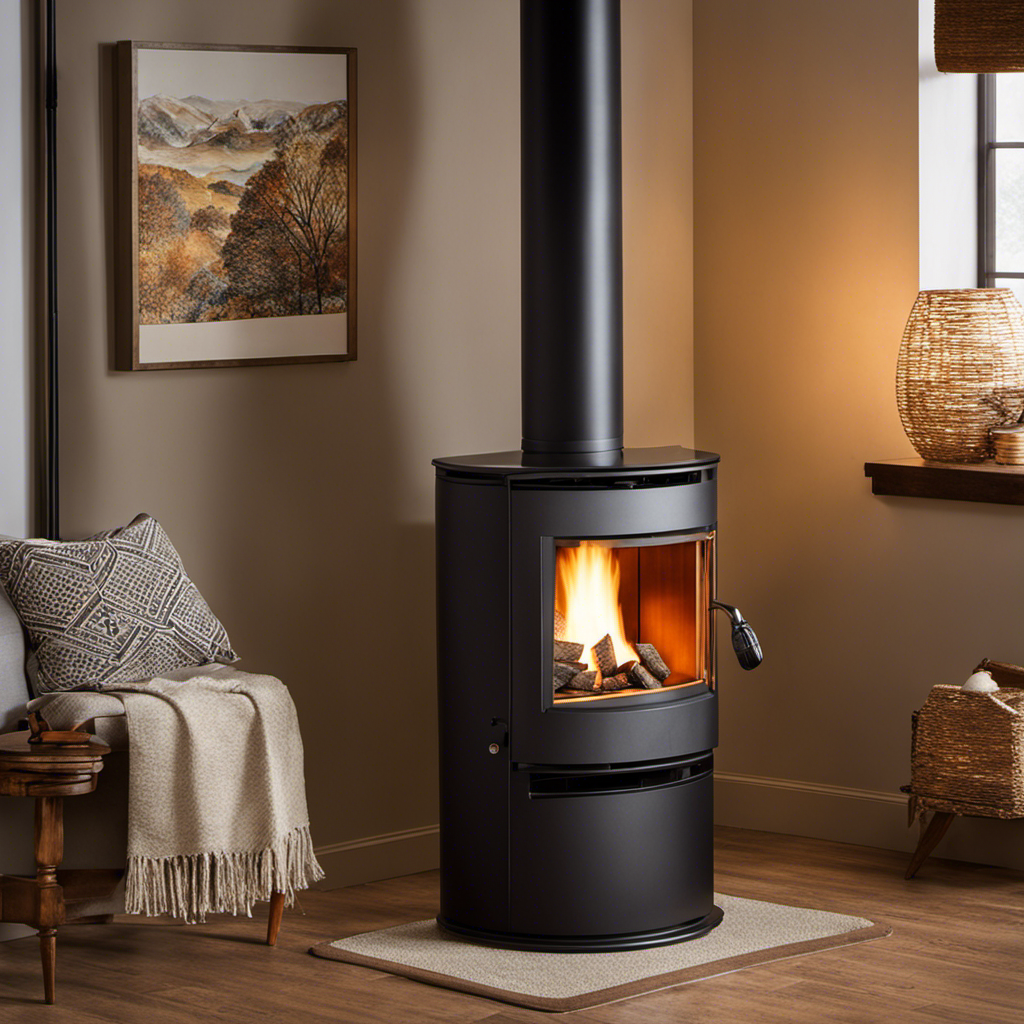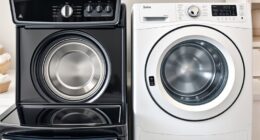As a fervent aficionado of wood pellet stoves, I can affirm that the cozy warmth they offer is unmatched.
In this article, I’ll guide you through the ins and outs of heating your home with a wood pellet stove.
From choosing the right stove to understanding the different types of pellets, I’ve got you covered.
With proper installation and maintenance, efficient operation techniques, and safety precautions, you’ll be able to maximize heat output while enjoying the environmental benefits.
So, let’s dive in and discover the wonders of heating with a wood pellet stove.
Key Takeaways
- Consider heating capacity, efficiency, and ease of maintenance when choosing a wood pellet stove.
- Wood pellet stoves are environmentally friendly and use renewable energy sources.
- Proper installation and maintenance maximize heat output and environmental benefits.
- Pellet quality standards are crucial for optimal performance and efficiency.
Choosing the Right Wood Pellet Stove
To choose the right wood pellet stove, you’ll need to consider factors such as heating capacity, efficiency, and ease of maintenance.
Wood pellet stoves are a popular choice for heating homes due to their numerous benefits. They are environmentally friendly, as they burn clean and produce minimal emissions. Additionally, wood pellets are a renewable energy source, making them a sustainable option.
When it comes to maintenance, wood pellet stoves require regular cleaning to remove ashes and ensure proper functioning. It’s important to clean the stove’s burn pot, exhaust pipes, and fans regularly to prevent any build-up that could affect performance. By choosing a wood pellet stove with easy access to these components, you can simplify the maintenance process.
Now that we understand the importance of wood pellet stove maintenance, let’s dive into understanding the different types of wood pellets.
Understanding the Different Types of Wood Pellets
When it comes to wood pellets, there are several important factors to consider.
First and foremost, understanding pellet quality standards is crucial in ensuring optimal performance and efficiency of your wood pellet stove.
Additionally, choosing the right pellet for your specific needs and stove model is essential for achieving maximum heat output and minimizing maintenance issues.
Lastly, proper storage and handling of wood pellets is key to preserving their quality and preventing any potential moisture or contamination issues.
Pellet Quality Standards
You can ensure the quality of your wood pellets by checking for specific standards and certifications. Here are four key factors to consider when evaluating pellet quality:
-
Pellet Certification Process: Look for pellets that have been certified by a reputable organization, such as the Pellet Fuels Institute (PFI) or the ENplus certification system. These certifications ensure that the pellets meet certain quality standards and are manufactured using sustainable practices.
-
Moisture Content: High-quality pellets should have a moisture content of less than 10%. Excess moisture can lead to poor combustion and reduced heat output, so it’s important to store pellets in a dry environment.
-
Ash Content: Low ash content is a sign of higher quality pellets. Look for pellets with an ash content of less than 1%. This will minimize the amount of residue left in your stove and reduce the need for frequent cleaning.
-
Pellet Storage Requirements: Proper storage is essential to maintaining pellet quality. Store pellets in a cool, dry place, away from any moisture or potential sources of ignition. It’s also important to keep the pellets protected from pests, such as rodents or insects.
By following these guidelines, you can ensure that you’re using high-quality wood pellets that will provide efficient and clean heat for your home.
Now let’s move on to choosing the right pellet for your specific needs.
Choosing the Right Pellet
Now that we’ve covered pellet quality standards, let’s focus on selecting the ideal pellet for your requirements. When it comes to choosing the right wood pellet, there are a few factors to consider. First, you want to look for reputable wood pellet brands that have a proven track record of producing high-quality pellets. These brands have invested in research and development to ensure consistent pellet quality. Additionally, consider pellet fuel efficiency. Look for pellets that have a high heat output and low ash content. To help you make an informed decision, here is a comparison table of different wood pellet brands:
| Brand | Heat Output (BTU/lb) | Ash Content (%) | Price per Bag ($) |
|---|---|---|---|
| Brand A | 8,000 | 1 | 6 |
| Brand B | 8,500 | 0.5 | 7 |
| Brand C | 7,500 | 1.5 | 5 |
| Brand D | 9,000 | 0.3 | 8 |
As you can see, Brand D offers the highest heat output and lowest ash content, but it also comes at a slightly higher price. Consider your budget and heating needs when making your decision. Now, let’s move on to storage and handling tips for wood pellets without skipping a beat.
Storage and Handling Tips
To properly store and handle your pellets, it’s important to keep them in a dry and well-ventilated area. Here are some tips to ensure the optimal storage and handling of your wood pellets:
-
Choose a clean and dry area: Find a space that is free from moisture and dust. This will prevent any damage to the pellets and maintain their quality.
-
Use airtight containers: Invest in airtight containers or bags to store the pellets. This will prevent moisture from seeping in and keep the pellets dry.
-
Avoid direct contact with the ground: Place the pellets on pallets or racks to keep them off the ground. This helps to avoid any moisture absorption and allows for proper airflow.
-
Handle with care: When moving or handling the pellets, be gentle to avoid any breakage. Use proper lifting techniques and sturdy containers to prevent accidents.
By following these storage and handling tips, you can ensure that your pellets remain in top condition for efficient heating.
Now, let’s move on to the proper installation of a wood pellet stove, which is crucial for safe and effective operation.
Proper Installation of a Wood Pellet Stove
Make sure that your wood pellet stove is properly installed to ensure safe and efficient heating. Proper installation is crucial for the optimal performance of your stove and to prevent potential hazards. Here are some important tips for the proper installation of a wood pellet stove.
First, ensure that you have an appropriate location for the stove. Choose a well-ventilated area away from combustible materials. Install the stove on a non-combustible floor or use a heat shield.
Next, carefully follow the manufacturer’s instructions for installing the stove, including the venting system. Improper venting can lead to smoke buildup and carbon monoxide poisoning.
Avoid common installation mistakes such as using the wrong type or size of vent pipe, failing to properly seal joints, or neglecting to clean the vent regularly.
By following these proper installation tips, you can ensure safe and efficient heating with your wood pellet stove.
Now, let’s move on to the next section about maintaining and cleaning your stove.
Maintaining and Cleaning Your Wood Pellet Stove
Regular maintenance and cleaning are essential for ensuring the longevity and efficiency of your wood pellet stove. Here are some important cleaning and maintenance tasks to keep your stove in top condition:
- Clean the burn pot regularly to remove any ash buildup that can affect the stove’s performance.
- Check and clean the exhaust vent to prevent any blockages that can lead to poor combustion and potential fire hazards.
- Inspect and clean the hopper and auger system to ensure smooth pellet feed and prevent any jams.
- Regularly clean the glass door to maintain a clear view of the fire and prevent any soot buildup.
By following these cleaning and maintenance procedures, you can troubleshoot potential issues and keep your wood pellet stove running efficiently.
Now, let’s move on to efficient operation techniques for wood pellet stoves.
Efficient Operation Techniques for Wood Pellet Stoves
Using efficient operation techniques can help maximize the performance and heat output of your wood pellet stove. Here are some important tips to ensure your stove operates at its best:
| Technique | Description | Benefits |
|---|---|---|
| Regular Cleaning | Remove ash and debris from the burn pot | Prevents clogs and promotes efficient burning |
| Proper Fuel Storage | Store pellets in a dry, cool area | Maintains pellet quality for optimal burning |
| Adjusting Air Intake | Fine-tune the air-to-fuel ratio | Controls combustion and heat output |
| Routine Maintenance | Inspect and clean components regularly | Ensures proper functioning and efficiency |
| Troubleshooting Problems | Address issues promptly and properly | Prevents further damage and maintains efficiency |
Safety Precautions for Wood Pellet Stove Usage
To ensure safe usage of a wood pellet stove, it’s important to follow these precautions:
-
Clean the stove regularly: Regularly remove ash and debris from the stove to prevent buildup, which can lead to decreased efficiency and increased risk of fire.
-
Install carbon monoxide detectors: Carbon monoxide is a colorless, odorless gas that can be produced by wood pellet stoves. Install detectors near the stove and in sleeping areas to ensure early detection and prevent carbon monoxide poisoning.
-
Keep flammable materials away: Maintain a safe distance between the stove and any flammable materials such as curtains, furniture, or paper. This will reduce the risk of accidental fires.
-
Monitor ventilation: Ensure that the stove is properly ventilated to prevent the buildup of harmful gases and to promote efficient combustion.
By following these precautions, you can enjoy the warmth of your wood pellet stove while minimizing the risks associated with fire prevention and carbon monoxide safety.
Now, let’s move on to troubleshooting common issues with wood pellet stoves.
Troubleshooting Common Issues With Wood Pellet Stoves
I’ve encountered various ignition problems while using wood pellet stoves, but I’ve found effective solutions to address them.
One common issue is difficulty in starting the stove, which can be resolved by checking and cleaning the igniter and ensuring proper fuel and air flow.
Additionally, I’ve discovered effective fixes for poor pellet combustion. These include adjusting the air-to-fuel ratio, cleaning the burn pot, and using high-quality pellets.
Ignition Problems and Solutions
There’s a common issue with ignition when using a wood pellet stove, but there are solutions available. If you’re having trouble getting your wood pellet stove to ignite, try these troubleshooting solutions:
-
Check the power supply: Ensure that the stove is properly connected to a functioning power outlet. A faulty power source can prevent ignition.
-
Clean the igniter: Over time, the igniter can accumulate debris and become less effective. Clean it with a soft brush or replace it if necessary.
-
Adjust the air intake: Insufficient airflow can hinder ignition. Make sure the air intake is open and clean any obstructions.
-
Use high-quality pellets: Poor quality pellets can lead to ignition problems. Opt for dry pellets with a low ash content for better combustion.
By addressing these ignition troubleshooting solutions, you can improve the performance of your wood pellet stove.
Now, let’s move on to fixing poor pellet combustion without delay.
Poor Pellet Combustion Fixes
One way to address poor pellet combustion is by adjusting the air intake to allow for better airflow. Ignition issues and pellet feeding problems can both contribute to poor combustion.
When the air intake is not properly adjusted, the pellets may not receive enough oxygen to burn efficiently. This can result in incomplete combustion and a decrease in heat output. By adjusting the air intake, you can ensure that the pellets are receiving the optimal amount of oxygen for combustion. This will help to maximize heat output and improve the overall efficiency of your wood pellet stove.
In the next section, we will discuss additional ways to maximize heat output from your wood pellet stove, including proper maintenance and fuel selection.
Maximizing Heat Output From Your Wood Pellet Stove
To maximize heat output from your wood pellet stove, it’s important to properly maintain and clean the stove on a regular basis. Here are some heating efficiency tips to help you increase your pellet stove’s performance:
- Clean the burnpot and ash pan regularly to prevent clogs and ensure proper air circulation.
- Check and clean the exhaust vent to remove any debris or obstructions that could impede airflow.
- Adjust the air intake and pellet feed rate to optimize combustion and heat output.
- Use high-quality pellets with low ash content to minimize residue buildup and maximize heat transfer.
By following these tips, you can ensure that your wood pellet stove operates at its highest efficiency, providing you with maximum heat output.
Now, let’s explore the environmental benefits of heating with wood pellet stoves.
Environmental Benefits of Heating With Wood Pellet Stoves
By using wood pellet stoves, you can reduce your carbon footprint and contribute to a cleaner environment. Wood pellet stoves are an excellent choice for heating your home due to their energy efficiency and environmental benefits.
These stoves are designed to burn wood pellets, which are made from compressed sawdust and other wood waste materials. Compared to traditional wood-burning stoves, wood pellet stoves produce significantly less smoke and emissions. This results in a drastic reduction in air pollution and greenhouse gas emissions.
Additionally, wood pellet stoves are highly efficient at converting the energy from pellets into heat, making them a cost-effective and environmentally friendly heating solution. By choosing to heat with wood pellet stoves, you are taking a proactive step towards reducing your carbon footprint and creating a cleaner, more sustainable future.
Frequently Asked Questions
Are Wood Pellet Stoves Suitable for Use in Small Spaces, Such as Apartments or Cabins?
Wood pellet stoves are suitable for small spaces like apartments or cabins. They provide efficient heating and have low maintenance requirements. The advantages of wood pellet stoves include cost-effectiveness, eco-friendliness, and the ability to control temperature easily.
Can I Use Wood Pellets Made From Different Types of Wood in My Wood Pellet Stove?
Yes, you can use wood pellets made from different types of wood in your wood pellet stove. This offers the benefit of choosing the type of wood that best suits your heating needs.
How Often Should I Have My Wood Pellet Stove Professionally Inspected and Serviced?
I recommend having your wood pellet stove professionally inspected and serviced annually to ensure proper maintenance. Signs that your stove needs servicing include decreased heat output, increased ash accumulation, and unusual noises.
Can I Leave My Wood Pellet Stove Unattended While It Is in Operation?
Yes, it is generally safe to leave a wood pellet stove unattended while it’s running. However, it’s important to follow safety guidelines and properly maintain your stove. Wood pellet stoves offer many benefits, including efficient heating and a renewable fuel source.
Are There Any Government Incentives or Tax Credits Available for Purchasing and Using a Wood Pellet Stove?
There are government incentives and tax credits available for purchasing and using a wood pellet stove. It’s great to see the government supporting sustainable heating options and encouraging more people to make the switch.
Conclusion
In conclusion, heating with a wood pellet stove offers an efficient and environmentally friendly alternative to traditional heating methods. By choosing the right stove, understanding the different types of wood pellets, and properly installing and maintaining your stove, you can enjoy a cozy and warm home throughout the winter.
Remember to follow safety precautions and troubleshoot any issues that may arise. So why not embrace the warmth and charm of a wood pellet stove? It’s time to turn up the heat and enjoy the comforting crackle of a fire in your own home.
Logan’s affair with adventure began in childhood. He hailed from a small town where vast forests bordered one side and endless shores stretched on the other. His days were spent exploring uncharted woods, climbing tall trees, or listening to the tales of old sailors. This early immersion in a world brimming with stories and mysteries became the foundation of his passion for writing.

